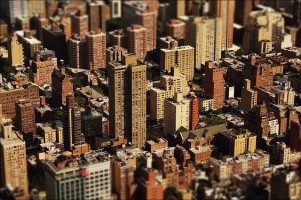Widgetized Section
Go to Admin » Appearance » Widgets » and move Gabfire Widget: Social into that MastheadOverlay zone
Comparing Urban Sprawl to Gentrification
The views expressed are those of the author and do not necessarily reflect the views of ASPA as an organization.
By Michael Silliman
October 18, 2016
Introduction
In the field of urbanism and city planning, much has been written about demographic changes over the last century and its effect on our cities. While pockets of conversations about “urban sprawl” and “gentrification” can be enlightening for understanding our experiences, they are commonly talked about as separate events. I would argue that while these challenges are different. They always seem to harm the same most vulnerable communities and actually stem from the same basic problem, namely, a failure in American development to provide engaging and sustainable communities. Moreover, these ideas are thought of as singular directional. That is that demographic change affects the kinds of infrastructure and communities we develop. I believe we need to see demographic change and the built environment as a complex relationship.
Urban Sprawl
Sprawl is talked about as a phenomenon that happened in the latter part of the 20th century. The line of thought goes like this: the postwar desire was to start a family and reach the American dream. When the baby boom happened, the suburbs were built to accommodate this growth.
In this line of thought, development is a result of the desires of middle-class families seeking to build their American Dreams. The problem with this explanation is that it assumes development of suburbs is the natural way for growth to occur. The major change in our development is seen as reactionary instead of intentional through subsidized home mortgage programs and the creation of the Federal Highway Administration by President Eisenhower in 1956. Moreover, it ignores the cultural behavior to seek a better life somewhere else instead of working to improve the community already inhabited.
The reality is more complex. Nowhere else in the world has such urban sprawl happened, and it turns out this is a very inefficient system. Strong Towns—a nonprofit with the mission of supporting a model of development that allows cities, towns and neighborhoods to become financially strong and resilient—explains development in America as an experiment scaled to the size of cars and not humans. Homes, jobs and “third places” have been pushed further and further apart, making commute times longer and walkability scores lower. It did not have to be this way.
Gentrification
 While last centuries problem was declining city populations and sprawl, the 21st centuries problem can appear totally opposite. Led by a young generation seeking jobs and education, our cities are booming. Washington D.C. has a net gain of 1,000 people every month, as explained by Greater Greater Washington. The Seattle Times reported major concerns as Amazon posted 11,042 job openings between May and August. The concerns, namely gentrification, are fair. Rapid growth can cause major governance problems and contribute to rising rents, pricing out the most vulnerable.
While last centuries problem was declining city populations and sprawl, the 21st centuries problem can appear totally opposite. Led by a young generation seeking jobs and education, our cities are booming. Washington D.C. has a net gain of 1,000 people every month, as explained by Greater Greater Washington. The Seattle Times reported major concerns as Amazon posted 11,042 job openings between May and August. The concerns, namely gentrification, are fair. Rapid growth can cause major governance problems and contribute to rising rents, pricing out the most vulnerable.
The explanation for gentrification is credited to demographic changes and fails to imagine alternative answers. The line of thought goes like this: another baby boom happened, the millennials. Coming out of the Great Recession of 2008 and 2009, the desires of this young generation were to get an education and a job. Consumer behaviors changed toward internet access and walkability, so developers built mixed-use, high-rise apartments in urban neighborhoods. The unintentional byproduct of which was low-income minorities being forced out of these newly desired neighborhoods.
This explanation makes the same two mistakes in my calculation as that of urban sprawl. First, it sees the starting place for development as the desires of middle-class consumers and as a response to demographic change. Instead, I challenge those in community development to see the current trend as multi-directional. There are push and pull factors that explain people moving into cities at such high rates. Or put differently, the built environment plays a major role in determining consumer behavior. As said in the Field of Dreams, “If you build it, he will come.” Second, there is no admission to failure in the old style of development, suburbs and single family homes. There lacks an explanation for why the alternative, continued growth in American towns and suburbs, is not a viable solution. Why can’t millennials find education and jobs in the suburbs?
Conclusion
The current conversation about development is just as shallow as our understanding of white flight. While declining urban populations and now rapid growth appear opposite, they are the result of an inability in American development to create sustainable communities. Populations with the ability to choose where they live are yet again leaving their homes seeking better lives elsewhere. Those without that ability, are left behind. It is not the opposite problem. In fact, it is the same repeating cycle or at least the reaction to the original problem.
Author: Michael Silliman holds a Master’s in Public Administration from George Mason University and currently runs the membership department at the American Society for Public Administration (ASPA). His career interests are in civil society, community development and third party governance.


Follow Us!